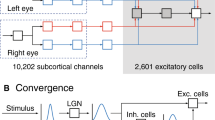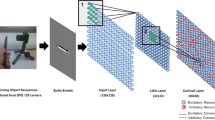Abstract
In our contribution we demonstrate, that orientation (OR) and ocular dominance (OD) cannot develop simultaneously in linear correlation-based learning (CBL) models, because OR and OD occupy separate domains in parameter space. We then analyse the conditions under which waves of spontaneous activity — as have been observed in the developing retina — may give rise at least to OR or OD. We find that in linear CBL models there must be subcortical convergence of ON/OFF as well as left eye/right eye pathways. We present a biologically plausible scenario in which the subcortical connectivity patterns resemble a competitive neural network and argue that OR and OD can robustly emerge, if a two-stage developmental process is assumed.
Similar content being viewed by others
References
E.Erwin, K.Obermayr, and K.Schuiten, “Models of orientation and ocular dominance columns in the visual cortex: A critical comparison”, Neural Computation, Vol. 7, pp. 425–468, 1995.
S.LeVay, T.N.Wiesel, and D.Hubel, “The development of ocular dominance columns in normal and visually deprived monkeys”, Journal of Comparative Neurology, Vol. 191, pp. 1–51, 1980.
R.Linsker, “From basic network principles to neural architecture: Emergence of orientation columns”, Proc. Natl. Acad. Sci. USA, Vol. 83, pp. 8779–8783, 1986.
K.D.Miller, “A model for the development of simple cell receptive fields and the ordered arrangements of orientation columns through activity-dependent competition between ON- and OFF-center inputs”, Journal of Neuroscience, Vol. 14, pp. 409–441, 1994.
K.D.Miller, J.B.Keller, and M.P.Stryker, “Ocular dominance column development: Analysis and simulation”, Science, Vol. 245, pp. 605–615, 1989.
K.Obermayer and G.G.Blasdel, “Geometry of orientation and ocular dominance columns in monkey striate cortex”, Journal of Neuroscience, Vol. 13, pp. 4114–4129, 1993.
H.C.Pape and U.T.Eysel, “Binocular interactions in the laterial geniculate nucleus of the cat: Gabaergic inhibition reduced by dominant afferent activity”, Experimental Brain Research, Vol. 61, pp. 265–71, 1986.
M.Stetter, A.Müller, and E.W.Lang, “Neural network model for the coordinated formation of orietnation preference and orientation selectivity maps”, Physical Review E, Vol. 50, pp. 4167–4181, 1994.
T.N.Wiesel and D.H.Hubel, “Ordered arrangement of orientation columns in monkeys lacking visual experience”, Journal of Comparative Neurology, Vol. 158, pp. 307–318, 1974.
R.O.L.Wong, M.Meister, and C.J.Shatz, “Transient period of correlated bursting activity during development of the mammalian retina”, Neuron, Vol. 11, pp. 923–938, 1993.
Author information
Authors and Affiliations
Rights and permissions
About this article
Cite this article
Piepenbrock, C., Ritter, H. & Obermayer, K. Linear correlation-based learning models require a two-stage process for the development of orientation and ocular dominance. Neural Process Lett 3, 31–37 (1996). https://doi.org/10.1007/BF00417787
Issue Date:
DOI: https://doi.org/10.1007/BF00417787




